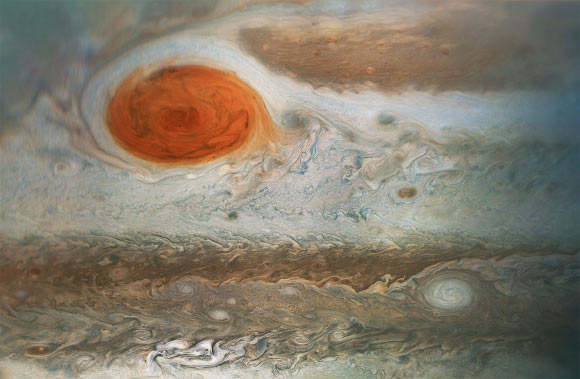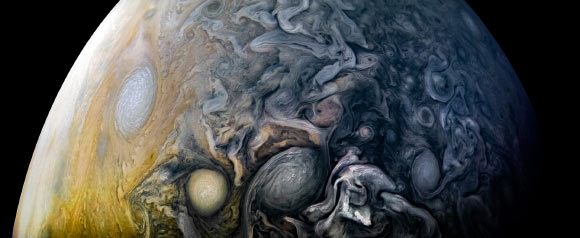NASA’s Juno mission took its twelfth trip around Jupiter on April 1, 2018, and the orbiter has sent back extraordinary images of the gas giant.

This image of Jupiter’s Great Red Spot and surrounding turbulent zones was captured by NASA’s Juno spacecraft. The color-enhanced image is a combination of three separate images taken on April 1 between 6:09 a.m. EDT (3:09 a.m. PDT) and 6:24 a.m. EDT (3:24 a.m. PDT). At the time the images were taken, the spacecraft was 15,379 miles (24,749 km) to 30,633 miles (49,299 km) from the tops of the clouds of the planet at a southern latitude spanning 43.2 to 62.1 degrees. Image credit: NASA / JPL-Caltech / SwRI / MSSS / Gerald Eichstaedt / Sean Doran.
Juno launched in August 2011 from Cape Canaveral, Florida, aboard an Atlas V 551 rocket, and arrived in orbit around Jupiter in July 2016.
The space probe is in a polar orbit around the giant planet, and the majority of each orbit is spent well away from the planet.

This image of Jupiter was taken on April 1 as Juno performed its twelfth close flyby of Jupiter. Image credit: NASA / JPL-Caltech / SwRI / MSSS / Kevin M. Gill.
But, once every 53 days, Juno’s trajectory approaches Jupiter from above its north pole, where it begins a 2-hr transit — from pole to pole — flying north to south.
During these flybys, the spacecraft is probing beneath the obscuring cloud cover of the planet and studying its auroras to learn more about its origins, structure, atmosphere and magnetosphere.

This Juno image hows intricate cloud patterns in the northern hemisphere of Jupiter. The color-enhanced image was taken on April 1 at 5:32 a.m. EST (2:32 a.m. PST), as Juno performed its twelfth close flyby of Jupiter. At the time the image was taken, the spacecraft was about 7,659 miles (12,326 km) from the tops of the clouds of the planet at a northern latitude of 50.2 degrees. Image credit: NASA / JPL-Caltech / SwRI / MSSS / Kevin M. Gill.
On April 1, 2018, Juno successfully made its twelfth close flyby of Jupiter.
At the time of perijove (the point in Juno’s orbit when it is closest to the planet’s center), the spacecraft was about 2,100 miles (3,500 km) above Jupiter’s cloud tops.







